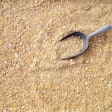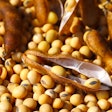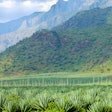Alternative ingredient offers nutritional
supplementation for pregnant nannies
When I saw that Dr. Frank Craddock, Texas A&M professor
and goat and sheep specialist, was retiring after 29 years, I wanted to seize
the opportunity to pick his brain about any nutritional challenges or suggestions
he may have pertaining to commercial goat production.
During the hour-long conversation, Craddock shared his
wealth of knowledge about goat production and the nutrition challenges facing
producers. In trying to identify one specific formulation or ingredient
opportunity for the purpose of creating this blog, I narrowed the discussion
down to one popular feeding topic: protein alternatives.
Nanny nutrition
“The goal of my nutrition program is to feed that doe so I
can get her bred with the most babies and then keep her pregnant for 150 days
so she has strong, live kids at the end,” Craddock says. “The period I worry
about is late gestation. During the last trimester, the most growth occurs. That’s
when you have to up the nutrition: more protein, more energy.”
Nannies become pregnant in the fall and their third
trimester typically falls in the late winter – a time when quality forage can’t
be found out on the range and the goats have to be fed. At this time,
producers roll out a supplementation program.
“The ingredient that bothers us the most is protein,” he
says. “If I can figure out how much protein my does need to meet their
requirement – and it’s not from the old, dried grass out there with 3 percent protein
– then I can decide what supplement to feed them until they can get enough on
pasture.”
The goal, at this point, is to find a whole feed ingredient
that can do the trick. In Texas – and other similar climates – whole cottonseed
is the abundant, high-protein solution.
Whole cottonseed and
cottonseed meal supplementation
Whole cottonseed (20 to 23 percent protein, 17 percent fat) and
cottonseed meal (41 percent protein, 4 to 5 percent fat) offer a high-energy,
high-protein alternative to soybean meal in ruminant diets. While cottonseed and
cottonseed meal prices have spiked in recent years, the ingredient remains “a
least-cost supplement per pound of protein.”
“Those products provide an excellent supplement out on the
range,” he says. “Some people extend the cottonseed meal with ground milo and
add salt to limit it.”
However, according to Craddock, two caveats should be taken
into consideration. First, the monogastric stomachs of kids under 60 days old
are intolerant to gossypol. After the first few weeks, once the kids begin
eating solid feedstuffs, the cottonseed and cottonseed meal should be kept away
to prevent illness or death. The second, according to Craddock, high levels of
cottonseed gossypol may have a negative effect on buck semen, so
refrain from feeding bucks whole cottonseed or rations with cottonseed in them.
Craddock notes that the use of cottonseed and the formulator’s
experience with it may be limited by regional availability, but that this
ingredient provides a viable protein alternative when it makes financial sense.


















